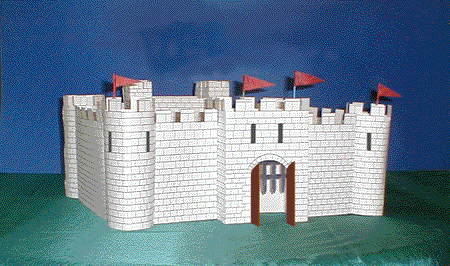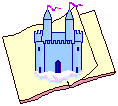Build a Medieval Castle online. No download, no installation, PC or
Mac; print
from your web browser.
Build a Medieval Castle Online
Go to Putting Your Castle Together
(Print these instructions out)
Castles were an important part of cultural, military, and political
history in Europe for many centuries. Although the Vikings
began raiding medieval towns and monasteries in the late 8th century, it
took a while for the development of elaborate fortifications.
Defenses developed from moats, mounded dirt and wooden palisades to
sophisticated stone castles built as a defense against both raiders and
foreign armies. Stone castles remained important until the effective
use of gunpowder in the 15th century made them easy to demolish.
(Other cultures, notably Asian, had their own buildings that served the
same purposes as castles, but we are only dealing with European castles
here.)
Typically the lord of the castle had a grant of land from the king or
other higher lord, which he ruled from his castle. Peasants were bound
to the land they worked, unable to go elsewhere. They owed part of
their harvest, and other taxes, to the lord. From his portion, the
lord had to feed himself and his family, his knights that fought for
him, and various servants around the castle, and pay for other things
that were needed.
The castle was for both defensive and offensive purposes. When
attacked by outsiders, people from the surrounding area would take
shelter in the castle. A fair number of people could
live for weeks within the castle walls, if they had brought adequate
provisions in with them. Essential to a castle’s defense during a siege
was a good, reliable well, within the castle wall or, better within the
keep itself.
A castle was designed around the concept of layers, forcing the enemy to
have to breach multiple obstacles or give up. To attack a castle,
the enemy had to get past the palisade, if there was one, and across the
moat, a deep ditch usually filled with water. To cross the moat
there was a drawbridge, which could be pulled up if an enemy threatened.
A good, wide moat made it more difficult to use siege engines against
the stone walls, or to try to undermine the castle walls. Also,
the attackers had great trouble getting their horses close to the
castle, so the attackers would be on foot. All of this time they
would be under fire from the fighters in the castle.
Beyond the drawbridge was a portcullis, a grate made of iron or wood in
a vertical slot which could be lowered quickly to stop intruders.
There were doors on the other end of the gatehouse, so that the
attackers could be trapped between the doors and the portcullis, and
then attacked from above.
In the ceiling with appropriately named murderholes made specifically to
allow defenders to bombard attackers with trash, hot tar, burning oil,
or arrows. On staircases to the guard towers—used for better sight
of the battle, better vantage points for archers, and dumping tar, mud,
and fire on the enemy—were spiral staircases, nearly impossible for a
right-handed warrior to fight upward, but easy for a right-handed man to
fight downward.
Inside the castle wall was the keep, a large, heavily-built building
that was the most secure place in the entire castle. This was
where the Great Hall was located, and where the private apartments of
the lord and his family were, possibly with a chapel, or a solarium.
If the castle walls were breached, the keep is the place everyone would
run to. In many cases, if a castle were attacked by an enemy army, and
the castle put under siege, the lord had already sent out messages to
allies to help relieve the siege. In that case, the castle
defenders were trying to hold out until help arrived. There was
generally a postern gate in the castle wall, at the back or side,
probably near the kitchen, for use by tradesmen bring food, etc., to the
castle. It would consist of a low door, wide enough to allow only
a single person through and as concealed as possible. It would be
barricaded during an attack, but it also provided a “sally port”—someone
inside the castle could (maybe) sneak out to get a message through, or
even start a sneak attack on the besiegers.
Besides being a defensive fortification, the castle provided a base from
which the lord and his knights could ride out into the surrounding
countryside, to exert control of the area around the castle. To be
able to arrive quickly, with armed knights at your side, at any place in
the surrounding area, kept down the possibility of rebellion or
outlawry, or attack by an invader. The lord’s control over his
grant of land—either directly or through men he appointed—was essential
in keeping order. It provided some security to peasants and
townspeople from bands of outlaws, but it also made sure that any rules
or taxes imposed by the lord were enforced.
The castle was both a fortification and a residence, and the degree to
which it was one or the other could change with the political situation.
Castle were fortifications first, being built of stone, and were not
comfortable to live in. The lady of the castle would add
tapestries to the walls and have straw and sweet-smelling herbs strewn
on the floors, to help make the castle rooms more livable. As the
lord’s wealth increased, he would add features to the castle to make it
both more livable and more impressive.
The wife of the lord often was the one who actually ran the domestic
arrangements of the castle, attending to her husband, and supervising
the servants.. A noble lady was also expected to be well-learned in
etiquette, embroidery, and sewing. Castles were always cold; they were
made entirely out of stone, so no heat circulated or was kept inside.
Fires needed constant tending all over the castle. Any opening
that allowed fresh air or light also let in the cold. The amount
of glass was limited; some castles had stained glass in the chapel, if
the lord was rich enough to afford it.
Children were often cared for by servants until the age of seven, when
they were considered small adults. At that age, they were sent off
to serve in another noble’s household. This both formed alliances
and educated the children. Boys learned politics and falconry
while girls learned manners and embroidery. The nobility would seek to
arrange advantageous marriages for their children, often when the
children were toddlers. Marriages were made to keep the peace, expand
territory, and to make sure there would be a next generation of nobles.
Girls were suitable for marriage at thirteen and boys at fifteen, but
arrangements were often made years before the weddings.
Life in a castle was very different for servants, though it might still
be more pleasant that working in the fields. Servants woke up
before the lady of the castle, preparing food, setting the large table
in the grand hallway. The kitchen of a castle was generally located
outside of the keep, but near the great hall. Good food took a
long time to cook and the lord, lady, and knights loved to eat a variety
of it. When one meal was done, another was being prepared. The kitchen
centered around two fires, one for roasting large livestock or game, and
one for a large cauldron for soup and stew. People were always
skinning animals, plucking birds, stirring the cauldron, tending the
fire, turning the spit, or moving dishes. Feasts lasted for hours,
constantly requiring more food to be brought into the great hall.
Dishes were not washed in the kitchen, but outside, along with the
laundry.
Peasant life was very different from life in a castle. Serfs
were peasants that were forced to work the land around the castle in
exchange from protection from invaders. They lived in rough huts,
probably made out of wattle and daub, worked the land, and were hungry
much of the time. Certain religious holidays were marked with
feasts at the castle for those close enough to get there. When war
threatened, the peasants would take refuge in the castle.
The peasants depended on their lords and castles more than they depended
on their king. Roads between towns and cities were leftover from
the Romans, so they were often broken, abandoned, and full of robbers
and murders while most of the stones from centuries ago had been looted
for building. Trade was difficult because travel was still
problematic due to the weather; rains turned the roads to impassable
mud, snow became a danger to animals and people while obscuring the road
The advent of gunpowder--and then artillery that made efficient use of
gunpowder-- made it easy to attack and take over a castle. No
longer useful as a defensive fortification, castles went out of use.
Their stones were taken away to build roads and other buildings.
Castles
in Medieval Times
|


